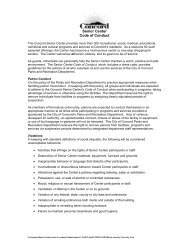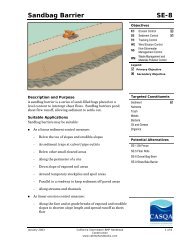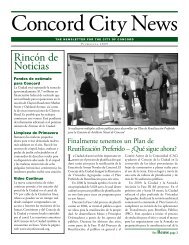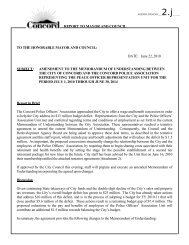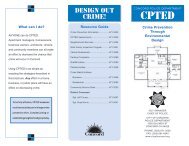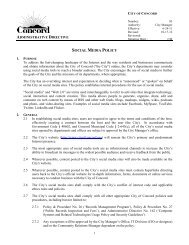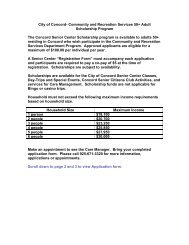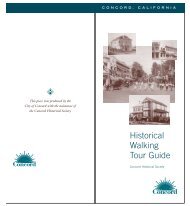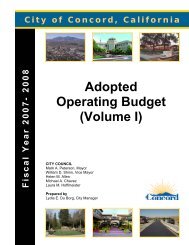Entrance/Outlet Tire Wash TC-3 - City of Concord
Entrance/Outlet Tire Wash TC-3 - City of Concord
Entrance/Outlet Tire Wash TC-3 - City of Concord
You also want an ePaper? Increase the reach of your titles
YUMPU automatically turns print PDFs into web optimized ePapers that Google loves.
<strong>Entrance</strong>/<strong>Outlet</strong> <strong>Tire</strong> <strong>Wash</strong><br />
<strong>TC</strong>-3<br />
Objectives<br />
EC Erosion Control<br />
SE Sediment Control <br />
<strong>TC</strong> Tracking Control <br />
WE Wind Erosion Control<br />
Non-Stormwater<br />
NS<br />
Management Control<br />
Waste Management and<br />
WM<br />
Materials Pollution Control<br />
Legend:<br />
Primary Objective<br />
Secondary Objective<br />
Description and Purpose<br />
A tire wash is an area located at stabilized construction access<br />
points to remove sediment from tires and under carriages and<br />
to prevent sediment from being transported onto public<br />
roadways.<br />
Suitable Applications<br />
<strong>Tire</strong> washes may be used on construction sites where dirt and<br />
mud tracking onto public roads by construction vehicles may<br />
occur.<br />
Limitations<br />
• The tire wash requires a supply <strong>of</strong> wash water.<br />
Targeted Constituents<br />
Sediment<br />
Nutrients<br />
Trash<br />
Metals<br />
Bacteria<br />
Oil and Grease<br />
Organics<br />
Potential Alternatives<br />
<strong>TC</strong>-1 Stabilized Construction<br />
<strong>Entrance</strong>/Exit<br />
<br />
• A turnout or doublewide exit is required to avoid having<br />
entering vehicles drive through the wash area.<br />
• Do not use where wet tire trucks leaving the site leave the<br />
road dangerously slick.<br />
Implementation<br />
• Incorporate with a stabilized construction entrance/exit.<br />
See <strong>TC</strong>-1, Stabilized Construction <strong>Entrance</strong>/Exit.<br />
• Construct on level ground when possible, on a pad <strong>of</strong> coarse<br />
aggregate greater than 3 in. but smaller than 6 in. A geotextile<br />
fabric should be placed below the aggregate.<br />
• <strong>Wash</strong> rack should be designed and constructed/manufactured<br />
for anticipated traffic loads.<br />
January 2003 California Stormwater BMP Handbook 1 <strong>of</strong> 3<br />
Construction<br />
www.cabmphandbooks.com
<strong>TC</strong>-3<br />
<strong>Entrance</strong>/<strong>Outlet</strong> <strong>Tire</strong> <strong>Wash</strong><br />
• Provide a drainage ditch that will convey the run<strong>of</strong>f from the wash area to a sediment<br />
trapping device. The drainage ditch should be <strong>of</strong> sufficient grade, width, and depth to carry<br />
the wash run<strong>of</strong>f.<br />
• Use hoses with automatic shut<strong>of</strong>f nozzles to prevent hoses from being left on.<br />
• Require that all employees, subcontractors, and others that leave the site with mud caked<br />
tires and undercarriages to use the wash facility.<br />
• Implement SC-7, Street Sweeping and Vacuuming, as needed.<br />
Costs<br />
Costs are low for installation <strong>of</strong> wash rack.<br />
Inspection and Maintenance<br />
• Inspect and verify that activity–based BMPs are in place prior to the commencement <strong>of</strong><br />
associated activities. While activities associated with the BMP are under way, inspect weekly<br />
during the rainy season and <strong>of</strong> two-week intervals in the non-rainy season to verify<br />
continued BMP implementation.<br />
• Inspect BMPs subject to non-stormwater discharge daily while non-stormwater discharges<br />
occur.<br />
• Remove accumulated sediment in wash rack and/or sediment trap to maintain system<br />
performance.<br />
• Inspect routinely for damage and repair as needed.<br />
References<br />
Blueprint for a Clean Bay: Best Management Practices to Prevent Stormwater Pollution from<br />
Construction Related Activities; Santa Clara Valley Nonpoint Source Pollution Control Program,<br />
1995.<br />
Coastal Nonpoint Pollution Control Program; Program Development and Approval Guidance,<br />
Working Group, Working Paper; USEPA, April 1992.<br />
Manual <strong>of</strong> Standards <strong>of</strong> Erosion and Sediment Control Measures, Association <strong>of</strong> Bay Area<br />
Governments, May 1995.<br />
Stormwater Quality Handbooks Construction Site Best Management Practices (BMPs) Manual,<br />
State <strong>of</strong> California Department <strong>of</strong> Transportation (Caltrans), November 2000.<br />
Stormwater Management for Construction Activities, Developing Pollution Prevention Plans<br />
and Best Management Practices, EPA 832-R-92005; USEPA, April 1992.<br />
2 <strong>of</strong> 3 California Stormwater BMP Handbook January 2003<br />
Construction<br />
www.cabmphandbooks.com
<strong>Entrance</strong>/<strong>Outlet</strong> <strong>Tire</strong> <strong>Wash</strong><br />
<strong>TC</strong>-3<br />
January 2003 California Stormwater BMP Handbook 3 <strong>of</strong> 3<br />
Construction<br />
www.cabmphandbooks.com



